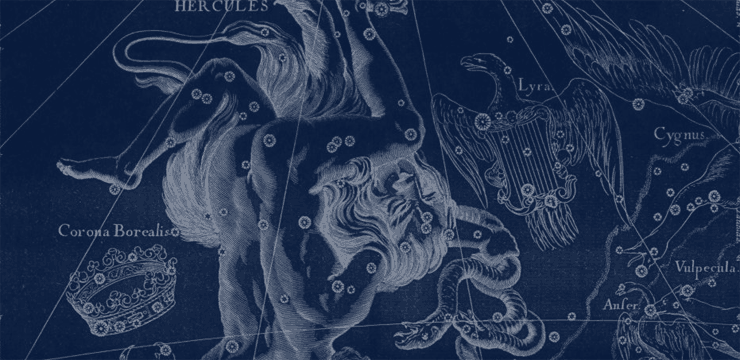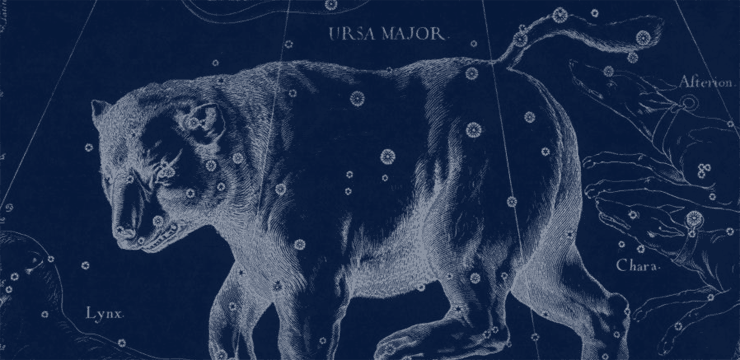
July Constellations & Folklore
July 2011 :
The really warm weather is here, and with it come the two giants in the sky: Hercules and Ophiuchus. Just about everybody’s heard of Hercules, because of the many movies made of him, based on his incredible myths and legends, and the fact that we’ve already encountered two of his labors in the sky, Leo, the Lion, and Hydra, the Water Snake. And now, as we are just fully getting into the hot days of July, the man himself is climbing toward his highest southern position.
Although his stars aren’t the brightest, Hercules is rather easy to find, because his body is a distinct crooked square almost directly overhead, the asterism the Keystone. Lines from each direction outward from this shape actually seem to have his body resemble his initial, a thick, blocky “H.” Also, if you’re still at the Keystone, and happen to be in a very dark sky, you might just be able to see one of the largest globular clusters in our sky – M13. From the right, or western side of the Keystone, follow to about 1/3 of the way downward, then gaze just a tad to the right. If you can’t make it out naked eye, a pair of binoculars will show you this object rather easily.
According to sky legends, Hercules is positioned upside-down in the sky so he can be head-to-head with the second of our celestial giants, Ophiuchus, the Doctor. Ophiuchus discovered the magic formula to eternal life; unfortunately for him, this didn’t bode well for Pluto, the god of the Underworld, who would then lose all his future inhabitants, so Pluto sent a serpent down to Ophiuchus, under the premise that should the good doctor prove victorious, we would all life forever; if the serpent won, Pluto would continue to receive us at the end of our lives. We can see the battle still raging, because on either side of Ophiuchus is a section of the snake, the constellation Serpens.
Once you’ve found the head of Hercules, the star just below this, which looks like the tip of a rooftop, is the doctor’s head. His entire body is more reminiscent of a blown-out house than a great physician, but he does use up a lot of the sky. Moving down each side of his body, you can see a squiggly line of stars, a short, almost straight line on his left, or east side, and an elongated set on his west, ending with a triangle, the serpent’s head, although some think it looks more like Satan’s tail. You can actually follow the entire serpent, as it slithers across Ophiuchus’s body, but because of the physics law that no two objects can occupy the same space at the same time, the doctor takes precedence. Therefore, Serpens is the only constellation in two parts – the section on the right, or west, is Serpens Caput, the Serpent’s head, leaving the tail, Serpens Cauda, to the left, or east.
Lately, there’s been publicity about Ophiuchus, as he happens to be a part of the sky through which the Sun passes during the course of the year. This region, known as the zodiac, contains the ecliptic, the defined path of the Sun. For about three weeks of the year, the Sun is within the Doctor, as opposed to the constellation which is normally listed as the relevant “sign” of that time, one of the most recognizable shapes of the sky, Scorpius, the Scorpion. From our latitude, the entire body of this amazing arachnid is visible. His tail scrapes the southern horizon as it moves across our sky. Scorpius is usually considered the animal that put an end to Orion, the Hunter, who boasted he would kill every animal on Earth. Because of the scorpion’s great deed, he and Orion are diametrically opposed in the sky – Orion can only show himself in the winter sky, when the scorpion allows. As soon as Scorpius wishes to rise above the horizon, Orion must set in the west.
The scorpion’s stinger was often considered similar to tracks made by rabbits as they hop in soft sand, and, their position in the sky was related to planting time. When the rabbit tracks were rising out of the east, it was time to seed; the best part of the growing period was when they were visible in the south, and as they set in the west, harvest time.
In the Pacific isles, as there are no scorpions in their lands, this constellation took on a very important part of the natives’ lives – a fishhook. Scorpius was the fishhook that the fisherman Maui cast into the ocean. Somehow, it got caught on the ocean floor, and when Maui was finally able to extricate it and bring it back up, attached to the hook was the Hawaiian Islands.
When to Observe
Constellations
Related Topics




